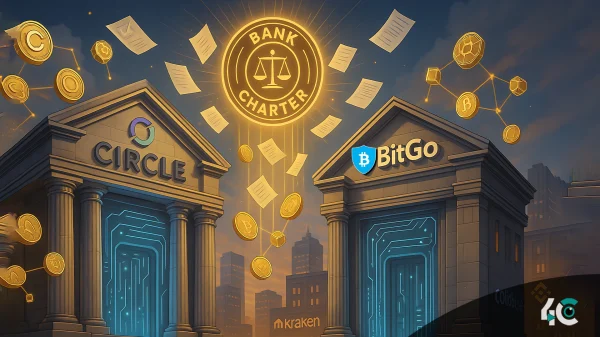Crypto is a decentralized economic system rather than conventional paper money. A valuable commodity can now be transferred from one individual to another. Even daily purchases can be done with Crypto, so long as the individual or company recognizes Crypto as a payment option. You can use crypto credit cards just like traditional (Credit/Debit) cards, except that you are spending your asset instead of cash.
In the beginning, when cryptocurrency was a relatively new asset class, there weren’t too many cryptocurrency credit cards on offer. There are a number of excellent crypto credit and debit card solutions on the market now, as the industry has grown and digital assets are becoming increasingly popular.
This article explores the basics of cryptocurrency credit cards, how they operate, and which cryptocurrencies can be used as debit cards.
What Is a Crypto Credit Card?
Cardholders of crypto credit cards can spend their digital assets just like cash with these cards. You can use your cryptocurrency credit card in stores without dedicated crypto payment gateways by using traditional payment networks such as Visa and MasterCard. By providing a new use case for cryptocurrencies, crypto credit cards bridge the gap between the digital asset space and the traditional world.
By holding some cryptocurrency in their wallets, cardholders can pay their bills, buy coffee, or use crypto for other products and services. The crypto enthusiasts who use their cryptocurrency debit cards in their stores also provide a benefit to merchants who do not have dedicated payment gateways for digital assets.
How Do Crypto Credit Cards Work?
In general, you load your digital assets onto a credit card by sending them to a dedicated cryptocurrency wallet (usually on the platform provided by the service provider). In order to load crypto credit cards with digital assets, you may need to convert them into fiat currency.
Additionally, some service providers do not require their users to store their cryptocurrencies in dedicated wallets. Therefore, you can load funds onto your card using any (compatible) wallet you prefer.
Once you’ve loaded your crypto onto your card, you are ready to make payments. This card works like a traditional debit card. In other words, you can make all sorts of payments while you are on your way to work, from paying your rent and utility bills to buying beer or your favorite latte.
If your card provider does not require you to convert your digital assets into fiat currency before making a purchase, your cryptocurrency will be automatically converted into cash. You’ll find multiple periodical limits on your crypto card, just like you do on prepaid cards (e.g., maximum balance, daily purchase limit, monthly top-up limit).
Some crypto debit card solution providers use universal limits for all customers. In some cases, tier-based systems are used, where the higher tier members have increased limits and are eligible for premium features (e.g., access to airport lounges, cashback rewards).
In order to upgrade their tier, users have to pay a subscription fee or stake cryptocurrency (lock up some coins in their wallets for a set period of time).
What Are the Best Crypto Credit and Debit Cards?
Here we have compiled a list of the five most popular crypto debit card solutions.
1. Crypto.com Visa Card
Overview
Among the most popular cryptocurrency credit cards on the market, Crypto.com’s Visa Card is one of the most popular. Users get rebates in CRO tokens for purchases made with the Crypto.com Visa Card thanks to its crypto cashback rewards system.
The Crypto.com platform not only provides the Visa Card, but also an ecosystem where users can store, trade, earn, and use their coins as collateral for loans.
Fees
The issuance of cards is free. Maintaining your account is also free. Despite being free to deposit crypto and to exchange it for other coins, Crypto.com charges a small withdrawal fee. Additionally, you will be charged a 3.5% fee for exchanging fiat to crypto instantly using your credit or debit card.
Your account tier determines the amount of free ATM withdrawals you can make every month ($200 for the lowest tier). You will be charged a 2% fee on ATM withdrawals once you reach that limit. If you reach your monthly limits ($2,000 for the lowest tier) you will have to pay 0.5% for interbank exchanges.
Availability
Several countries throughout APAC and the European Union accept the MCO Visa Card.
2. Coinbase Card
Overview
The EEA-based crypto debit card solution offered by Coinbase, one of the most popular cryptocurrency exchanges, was released in 2019. Coinbase cardholders can use their Coinbase Wallet balance to fund their cards directly with crypto, including Bitcoin, Ethereum, Bitcoin Cash, Ripple, Basic Attention Token, Augur, 0x, Stellar Lumens, and Litecoin.
Fees
Coinbase charges 4.95 EUR for card issuance, but there are no fees for account maintenance. Withdrawing cash from a domestic ATM costs you 1%, while withdrawing cash from an international ATM costs 2% after you’ve reached your free withdrawal limit. Coinbase also charges your card for international transactions 3% for international transactions and 0.2% for intra-EEA POS transfers.
Availability
Coinbase Card is currently available only in the European Economic Area.
3. Wirex Visa Card
Overview
A crypto debit card solution offered by Wirex is among the oldest on the market. Wirex offers a blockchain debit card in addition to a mobile app that includes a built-in crypto wallet and exchange. Both fiat currency and digital assets can be used to fund the app. With the Wirex Card you get crypto cashback rewards (in BTC). You will receive crypto rebates on your transactions based on how many Wirex Tokens (WXT) you hold.
Fees
Wirex does not charge any fees for the issuance and delivery of cards, but there is a monthly maintenance fee of 1.20 EUR. For international transactions, Wirex charges an additional 3% foreign exchange fee, which is charged to both purchases and withdrawals made with non-domestic cards. For domestic ATM withdrawals, the fee is 2.25 EUR and for international ATM withdrawals, it is 2.75 EUR.
Availability
Wirex cards were initially only available to residents of the European Economic Area. Recent expansion into other regions (such as the APAC) has resulted in the company expanding its services.
4. Monolith Visa Debit Card (Formerly TokenCard)
Overview
Among the most exciting cryptocurrency credit card solutions is the Monolith Visa Debit Card. The Monolith Card offers users access to the Defi (decentralized finance) economy along with a crypto debit card that uses Ethereum’s network for digital asset wallets. This project runs on an ERC-20 token called TKN, which runs on the Ethereum blockchain. With the TKN coin, holders can receive fee discounts on card top-ups as well as redeem their Community Contribute share.
Fees
Monolith does not charge for account maintenance, card issuance, or shipping. A 1+1% fee is charged for funding your card. This includes community contribution fees paid by TKN holders who can withdraw their share at any time, and top-up fees paid by card holders.
The only thing to remember is that no matter which method you choose, you’ll have to pay a 1% fee for loading funds onto your card. Monolith lets you exchange fiat to crypto for free, but charges 1.75% for transactions done in currencies other than your base fiat (EUR or GBP).
Availability
In addition to the 31 countries of the EEC, Monolith Visa Debit Cards can also be used in multiple Special Member State Territories.
5. TenX Visa Card
Overview
TenX Visa Card has become one of the most popular services in Asia Pacific. As a virtual payment card, TenX’s cryptocurrency credit card can be used immediately upon approval.
Fees
It costs 15 USD or 15 EUR to issue physical crypto credit cards, and 5 USD or 5 EUR to issue virtual crypto credit cards. TenX charges a fee of $10 per year after the first year (which is free). This fee can be waived by spending at least $1,000 within one year.
For card shipping, crypto withdrawals, and deposits, TenX charges no fees. The TenX ATM cash withdrawal fee is 3.25 USD / 3 EUR. In addition, the service provider will charge a small spread when you convert fiat into crypto.
Availability
As of now, the TenX Visa Card is available in countries in Asia, Austria, and Germany.
How Do You Get a Crypto Card?
Here are the steps on how to obtain a crypto debit card now that you know the basics. There may be different steps to get a crypto card depending on the service provider you select.
Step 1: Registering an Account
To get a crypto debit card, you’ll need to open an account with a provider.
Your card will be loaded with cryptocurrency from a dedicated wallet. When you sign up for such a service, you will receive a crypto wallet.
Important: Whenever you receive a cryptocurrency wallet, make sure you keep the wallet’s secret keys safe. The documents can be kept either on your computer or printed and stored somewhere else. Private keys should remain private no matter where they are stored, and they should never be shared.
Step 2: Verifying Your Account
As a payment service provider, the company is subject to different regulations. To verify your identity and address, you must submit Know Your Customer (KYC) and Anti-Money Laundering (AML) documents. Depending on the purpose of your account or the source of your funds, you may also need to answer some questions. Verification of the documents will take some time after submitting them to the cryptocurrency credit card provider.
Step 3: Shipping and Activation
A crypto debit card will be sent to your address after successfully verifying your address. In some cases, this will be handled automatically, but in others, particularly ones that require users to stake cryptocurrency before they can unlock premium features, they may ask that you deposit Crypto into a certain wallet before shipping your card.
Be sure to know the exact requirements and risks involved with staking crypto to receive your card and unlock higher account tiers. After you receive your card, follow the instructions provided by your service provider to activate it.
Step 4: Crypto Credit Card Top-Ups
Once your cryptocurrency card is activated, send crypto to either a dedicated wallet or one that is compatible with it. We recommend you convert fiat to cryptocurrency on a prominent exchange, then send those coins to the card wallet if you do not possess any digital assets.
As stated above there are two different processes used in crypto card solutions.
- Digital assets can be loaded directly onto cryptocurrency debit cards as part of the services. This solution requires that you top up your card with coins.
- In some cases, it is sufficient to have your coins in the service provider’s dedicated wallet. The coins will then be automatically loaded on your card.
Crypto cards empower the industry with new use-cases and provide numerous benefits to users. These cards provide benefits ranging from cashback rewards and premium features to access to the Defi economy.



























